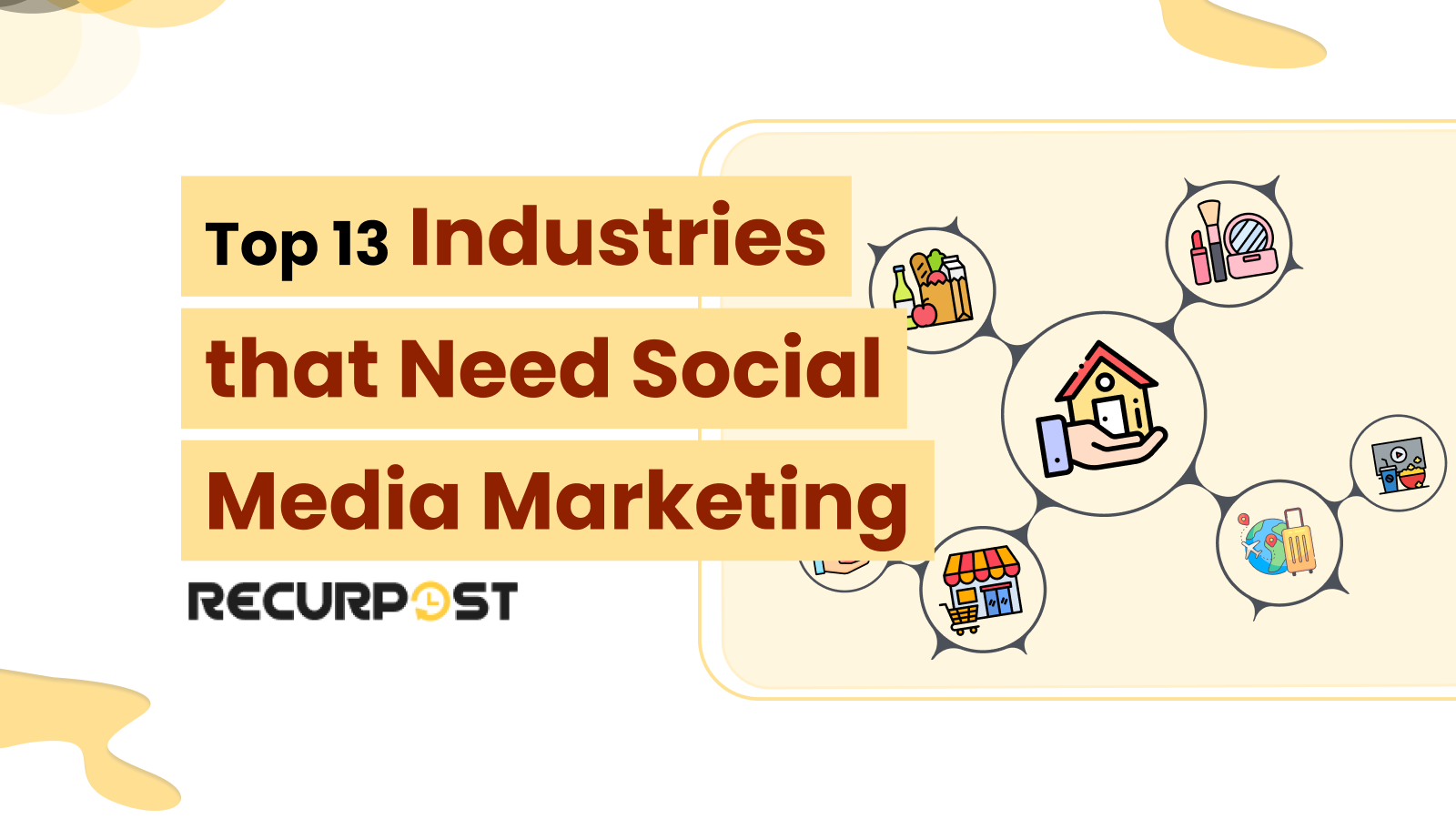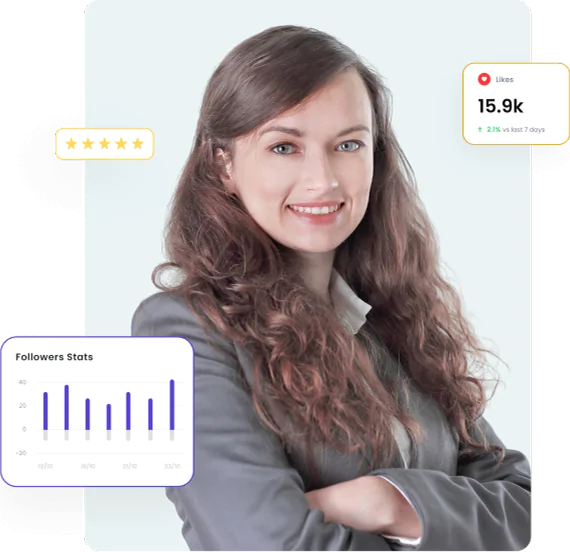In today’s digital world, industries that require social media marketing are not limited to tech companies but span across sectors. As businesses continue to adapt to the digital age, these industries that need social media marketing are learning how to effectively engage with diverse audiences, build brand awareness, and drive sales.
Social media marketing connects small businesses with diverse audiences, builds brand awareness, and drives sales. However, marketing techniques vary significantly from one industry to another. Each industry requires a unique social media strategy due to its distinct characteristics, target audience, regulations, and market dynamics.
For instance, retail companies have different needs compared to education institutions, while fashion brands approach social media marketing differently than healthcare providers. Understanding how social media can help businesses grow is crucial, as industries must develop unique and engaging campaigns that increase conversions, maximize profits, and accelerate ROI.
Key factors for agencies, managers, and marketers to align client goals with campaigns include audience analysis, content strategy, platform selection, competitive analysis, regulatory standards, innovation, and credibility building. This blog will explore how different industries effectively use digital marketing to advance their business objectives.
13 Industries that Need Social Media Marketing
Selecting the right social media platforms is key for businesses in industries that need social media marketing to effectively engage their target audiences. Real estate marketing companies, healthcare brands, fashion retailers, and technology firms are among the industries that need social media marketing the most, driving significant growth through strategic digital marketing. These sectors have successfully embraced social media to boost their brand visibility, connect with potential clients, and engage their communities.
By aligning social media strategies with industry-specific needs, businesses can create new growth opportunities. For example, real estate firms use Instagram for showcasing properties and engaging local buyers, while healthcare brands leverage platforms like LinkedIn and Facebook to build trust and educate patients. Similarly, fashion retailers use Instagram and Pinterest to showcase new collections and increase online sales, while technology firms engage through Twitter and YouTube to share product innovations and build an authority in the tech space.
Matching social media strategies to specific industries not only drives engagement but also opens doors for brand expansion, lead generation, and customer loyalty.
Learn How Social Media Affects Businesses
1. Real Estate
Ideal Platforms: Facebook, YouTube, Instagram, LinkedIn, TikTok
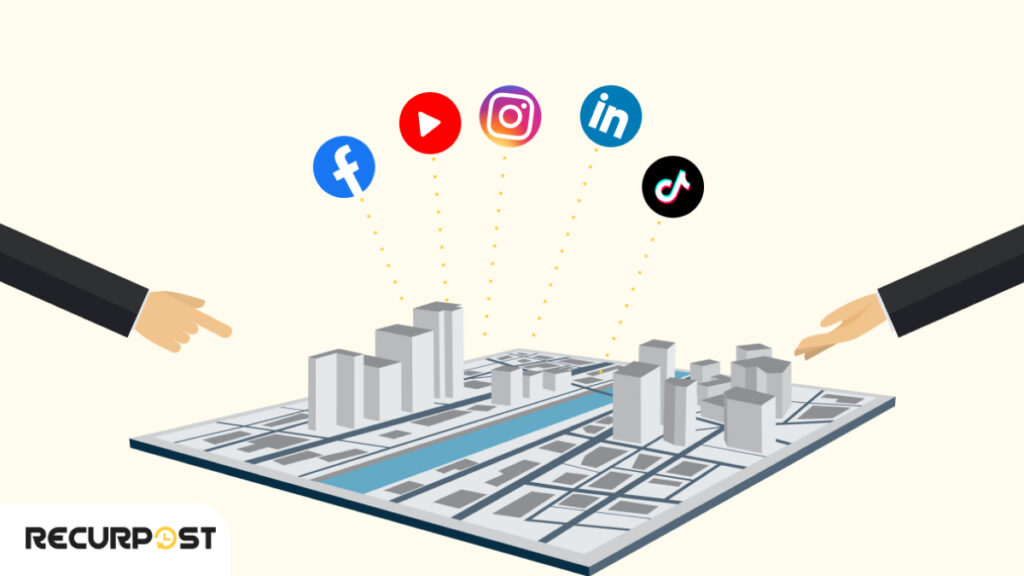
The National Association of Realtors survey revealed that 92%, 68%, 52%, and 26% of real estate professionals promote property listings on Facebook, Instagram, LinkedIn, and YouTube, respectively. This demonstrates the major role social media marketing plays in the real estate industry, making it one of the industries that need social media marketing the most.
Realtors, contractors, builders, brokers, dealers, and agents are leveraging these platforms for brand visibility, property advertisement, and audience engagement. Whether it’s through property management updates or sharing industry news, social media has become a key tool for engaging potential buyers and tenants.
Planning social media marketing for real estate involves:
- Audience Tailoring: Each sector within real estate (residential, industrial, commercial) has unique audiences, needs, and sales patterns. A one-size-fits-all approach doesn’t work here.
- Engaging Content: Real estate businesses engage customers by sharing market insights, house-hunting tips, investment ideas, and more. This content must be targeted, informative, and helpful to the audience.
- Visual Content: Uploading high-quality videos and images in online groups and applications allows property owners to reach the right people and avoid intermediaries, directly connecting with potential buyers.
- Testimonials & Success Stories: Featuring client testimonials and success stories on top social networks helps build trust and attract new clients.
Visual platforms such as Instagram and YouTube capture the attention of buyers, while cross-platform marketing drives website traffic, generates leads, and boosts attendance at open houses. Additionally, real estate professionals are increasingly using AI technologies like the Metaverse and AR/VR to virtually design properties, appealing to elite clients looking for innovative, cutting-edge experiences.
Check out the Real estate social media marketing strategy
2. Beauty & Fashion
Ideal Platform: Instagram, Facebook, TikTok, Pinterest, Snapchat

The beauty and fashion industries rely heavily on social media marketing due to the visual nature of their products. These industries use social media to build brand awareness, foster consumer loyalty, drive platform traffic, and deliver highly targeted ads. As a result, the beauty and fashion sectors are prime examples of industries that need social media marketing to thrive in today’s digital landscape.
Statista projects that the beauty and fashion industries will generate $14.68 billion and $646.2 billion in revenue, respectively, by 2024.
Beauty and fashion brands approach social media marketing in several key ways:
- Targeted Audience Segmentation: These businesses target specific audience segments by age, race, location, lifestyle, religion, mindset, and emerging trends, selecting the most appropriate platforms for each.
- Visual Showcases: Brands showcase their products through high-quality visuals, including professional photoshoots, ads, videos, images, and behind-the-scenes content, drawing attention and engagement.
- Cross-Platform Marketing: Fashion and beauty brands reach global audiences by integrating their marketing efforts across social media, email, blogs, TV ads, and online advertising, ensuring maximum visibility and engagement.
- Collaborations: Social media platforms are used to highlight collaborations with complementary, non-competing brands. This strategy is a powerful way to expand reach and engage multiple audience segments simultaneously. Influencer partnerships and paid collaborations help foster cross-pollination between brands, enhancing both brand visibility and audience engagement.
- Targeted Updates: Businesses share news about offers, new products, trends, seasonal items, and limited edition collections, all through targeted social media marketing strategies.
- User Engagement: Brands engage audiences through user-generated content (UGC), giveaways, contests, live sessions, and other interactive forms of content. For new businesses with limited marketing budgets, learning how to promote your business on social media for free using these engagement tactics can prove especially beneficial.
Influencer marketing is particularly effective in the beauty and fashion industries, significantly enhancing brand engagement. Sponsored content from influencers often outperforms organic posts, as it resonates deeply with followers. By collaborating with influencers, brands can create educational and entertaining content that appeals to their target audience.
3. Retail
Ideal Platform: Facebook, Instagram, Twitter, Reddit, YouTube

The American retail marketplace is projected to reach $603.2 billion by 2027, driven by the integration of both offline and online marketing efforts. Social media marketing plays a pivotal role in connecting retailers with global customers, adding convenience and value to the shopping experience. As one of the industries that need social media marketing, retail businesses are increasingly using social media to bridge the gap between brands and their audiences.
Retailers can connect with target audiences across various locations using these strategies:
- Small & Medium-Sized Retailers: These businesses leverage social media to reach untapped markets and build brand recognition. Online marketing through platforms like Facebook and Instagram drives promotions, sales, advertisements, and customer acquisition.
- Platform Selection: The ideal social media platform for retail businesses depends on their audience demographics and the type of products they sell. For example, food chains and fashion retailers thrive on Facebook and Instagram, while electronics retailers see better performance on platforms like YouTube and Reddit.
- AI-Powered Marketing: Retailers are increasingly using AI-powered marketing tools to enhance content creation, customer support, predictive analysis, reporting, and to gain a competitive edge. By leveraging AI, businesses can automate tasks and better understand consumer behavior.
- Hyper-Personalization: Retail and other customer-centric industries benefit from AI-driven hyper-personalization, which creates seamless integration between offline and online shopping experiences. This synchronization helps brands provide more targeted experiences for their customers.
4. Tourism & Hospitality
Ideal Platform: Instagram, Facebook, GBP, YouTube, TripAdvisor

Social media marketing plays a crucial role in the tourism and hospitality industries by helping businesses connect with potential travelers and guests. According to Forbes, 82% of travelers prefer digital research and booking, highlighting the growing importance of online presence. As one of the industries that need social media marketing, tourism and hospitality businesses must adopt tailored approaches to their digital marketing campaigns, moving away from generic solutions. Engaging content and valuable insights can increase conversion rates and help businesses stand out in a competitive market.
Strategies to build audience relationships include:
- Multi-Channel Marketing: Different social media platforms allow for varied marketing approaches. Visual platforms like Instagram and YouTube are perfect for showcasing stunning destination photos and videos, while text-based platforms like Facebook and TripAdvisor provide in-depth information about services, accommodations, and local attractions. A successful strategy involves integrating these channels and diversifying content formats to meet different user preferences.
- Captivating Content: Social media marketing in the travel industry thrives on captivating destination stories, customer experiences, and curated travel journeys. Aligning social media calendars with seasonal destination guides ensures content is relevant and impactful. By sharing inspiring stories and travel insights, businesses can foster deeper emotional connections with their audience.
- Guest-Focused Marketing: Hospitality and tourism marketing often focuses on showcasing guest experiences, highlighting local attractions, sharing travel tips, and offering comprehensive destination guides. This approach is essential for inspiring potential visitors and positioning your brand as a trusted travel resource.
- AI & Real-Time Engagement: Travelers often contact businesses with inquiries, feedback, or concerns. Implementing AI-generated real-time assistance builds trust and loyalty by providing immediate responses. Additionally, User-Generated Content (UGC) and behind-the-scenes content help humanize the business and create an authentic connection with the audience.
Delivering unique, detailed content is key to success. Businesses should share information on optimal visit times, safety tips, recommended accommodations, and local cuisine options to guide travelers. This content can be scheduled in advance and strategically posted during peak booking periods. Keeping a library of seasonal travel guides ensures that relevant content is always available for audiences during specific travel seasons.
Highlighting your unique selling proposition (USP) and special features in your social media content is essential for differentiating your brand. For example, tourism businesses can feature heritage tours, solo travel packages, or adventure excursions, while hospitality businesses can focus on offerings like wellness retreats, culinary excellence, or luxury stays.
5. Food & Beverage
Ideal Platform: Instagram, Facebook, TikTok, YouTube, Yelp

Social media has significantly transformed the food and beverage industry by providing consumers with direct access to food science, industry trends, and the latest dining experiences. Today’s consumers can easily explore global cuisine, discover new restaurants, and stay updated on the latest food trends, all thanks to social media marketing. As one of the industries that need social media marketing, food businesses are leveraging platforms to boost brand visibility, connect with customers, and drive sales.
The International Food Information Council(IFIC) predicts that social media will continue to influence snacking and cooking trends in 2024. Restaurants, cafes, and other food and beverage businesses can optimize their social media marketing strategies to maximize impact and stay ahead of the competition.
Key strategies for food and beverage businesses include:
- Comprehensive Content Creation: Behind-the-scenes shots, decor, staff highlights, and operations footage can help customers feel connected to your brand. Showing the skills, passion, and process behind the scenes creates transparency and builds trust.
- Marketing Innovation: Experimenting with various marketing techniques can help find what resonates best with your audience. Demonstrating unique selling propositions (USPs) such as robot servers, distinct cooking methods, smart ordering, or pet-friendly policies can attract new guests and create a buzz around your brand.
- Visual Content: The power of visual content is paramount in the food industry. Sharing mouth-watering images of dishes and showcasing your restaurant’s ambiance on platforms like Instagram and TikTok can help attract customers. Promoting seasonal menus, special offers, and discount coupons is a great way to convert first-time visitors into regulars.
- Excitement & Urgency: Limited-time offers, happy hours, and special events help generate excitement and encourage immediate action. Announcing partnerships with influencers and local businesses on your most engaging platforms helps expand your audience and build credibility.
- Humanizing Your Brand: Social media can be a powerful tool for building genuine relationships with your audience. Including testimonial videos, requesting reviews from loyal customers, and sharing user-generated content (UGC) help demonstrate your commitment to customer satisfaction and strengthen your brand’s authenticity.
- Trend Integration: Social media significantly influences snacking and cooking trends. Platforms like Instagram and TikTok showcase viral recipes, snack ideas, and food trends, which can drive new customer interest. By integrating trending items into your menu, you can stay relevant and attract a broader audience.
Use Facebook for Restaurants in the Best Possible Ways
6. Healthcare
Ideal Platform: Facebook, LinkedIn, YouTube, WhatsApp, Twitter

The COVID-19 pandemic accelerated the healthcare industry’s adoption of social media platforms to enhance global communication, build professional networks, and promote healthy practices. As Millennials and Gen Z prioritize health more than previous generations, digital platforms have become essential for providing immediate and reliable information.
Today, healthcare social media marketing is no longer a luxury but a necessity for reaching broader audiences. As one of the industries that need social media marketing, healthcare organizations are leveraging social media to expand their online presence and engage with patients and professionals alike.
Key strategies for healthcare organizations include:
- Appointment Scheduling & Inquiries: Social media platforms provide convenient booking features that enable appointment scheduling and resolution of basic inquiries without human interaction, offering patients quick and efficient access to services.
- Content Creation & Sharing: Sharing valuable healthcare insights through videos, images, blogs, and infographics is key for educating and engaging audiences. Content can cover a wide range of topics, from medical news to precautionary tips and illness information, helping to inform patients and the public.
- Brand Building: Doctors, hospitals, pharmacies, and other medical professionals use social media to share their values, mission, and services across platforms like LinkedIn and Facebook. This not only helps build a strong brand identity but also fosters trust and credibility with patients and the community.
- Medical Updates & Education: Social media is an efficient tool for distributing critical medical updates, patient stories, and health awareness campaigns. Sharing knowledge on emerging health trends and updates on healthcare services can enhance the reach of important information.
- Online Sessions & Q&A: Healthcare organizations increasingly host live Q&A sessions and online webinars to discuss plans, investments, and medical goals with the public. These sessions help in building transparency and trust with patients and stakeholders.
- Company Culture on LinkedIn: Social media is also used by healthcare organizations to showcase their company culture on LinkedIn, emphasizing values that resonate with both potential employees and clients. This approach aids in creating a trusted and approachable brand image.
- Authentic Presence: For healthcare professionals, maintaining an authentic social media presence is critical. Providing clear, trustworthy content while interacting with patients and followers helps establish a strong, credible online reputation.
7. Entertainment
Ideal Platform: Instagram, Facebook, YouTube, TikTok

Entertainment marketing has flourished on social media, allowing businesses to increase visibility and engagement across 5 billion global users. Social media has eliminated language, country, and genre barriers, making it a powerful tool for amplifying content in the entertainment industry. As one of the industries that need social media marketing, entertainment businesses can strategically use these platforms to enhance their reach and engagement.
Hype creation is a key factor driving success in entertainment marketing. With the right mix of platform choices and content strategies, businesses can create significant momentum in the market. Exclusive previews, snippets, teasers, and behind-the-scenes (BTS) content are all effective ways to spark audience conversations and build anticipation. Coordinating release announcements across platforms and scheduling promotional content leading up to events can maximize buzz and audience reach.
Key strategies for entertainment businesses include:
- Live Sessions & Virtual Meet-and-Greets: Engaging directly with the audience through live sessions, virtual meet-and-greets, and interactive quizzes can significantly boost social media visibility and engagement.
- Crew Interviews & Online Content: Hosting online interviews with actors, directors, and crew members provides fans with insider access and enhances viewer engagement. These sessions allow followers to connect more personally with the content and those behind it.
- Insider Details & Personal Stories: Sharing exclusive insider details, personal stories, and behind-the-scenes experiences helps deepen the connection with the audience, making them feel more involved and invested in the project.
- Project Announcements & Excitement: To drive excitement for upcoming projects, entertainment companies should create unique and compelling announcements. Examples could include collaborating with industry colleagues to promote the project, involving the audience in publicity campaigns, and planning suspense-filled cliffhangers to keep interest high.
- Event Promotion & Collaborations: Promoting events and collaborations is made easier through social media platforms. Digital platforms bring together talented people to create synergy, such as Bill Gates collaborating with Eitan Bernath for a cooking session, which drew massive attention. These kinds of partnerships can amplify visibility and create more engagement.
8. NGO / Non-Profit Organizations
Ideal Platforms: Facebook, Instagram, Twitter (X), LinkedIn, YouTube

Non-profit organizations use social media to build trust, engage supporters, and raise contributions. The UN Development Programme continuously encourages nonprofits to enhance their online presence, recognizing that social media marketing is a powerful tool for driving awareness and creating meaningful connections. As one of the industries that need social media marketing, NGOs rely on well-curated social media strategies to tell compelling stories, share updates, and foster community engagement.
The first step in how to promote an NGO on social media is selecting the right digital platforms to reach both potential donors and volunteers. Even with small social media marketing budgets, nonprofits can achieve significant impact when choosing platforms strategically. For example, Facebook and Instagram are ideal for visual storytelling, while LinkedIn is the perfect platform for professional partnerships and outreach efforts.
Key strategies for NGOs include:
- Live Sessions & Q&As: NGOs can connect emotionally with their audience by hosting live sessions and Q&As, where supporters can ask questions and engage with the organization’s work in real-time.
- Mission-Driven Content: Sharing content that highlights the organization’s mission, impactful stories, and supporter-generated content helps ensure transparency and authenticity. This strengthens the bond with the community and encourages further involvement.
- Awareness & Donations: Social media is one of the most effective strategies for spreading awareness, driving donations, and inspiring social change. Through targeted campaigns, NGOs can encourage followers to contribute to their cause and amplify their message.
- Behind-the-Scenes Content: Sharing celebratory moments or behind-the-scenes content allows NGOs to showcase the real work they’re doing, fostering deeper trust and encouraging long-term support. This content humanizes the organization and strengthens its relationship with supporters.
9. Music
Ideal Platforms: Instagram, YouTube, TikTok, Facebook, Twitter (X), Spotify
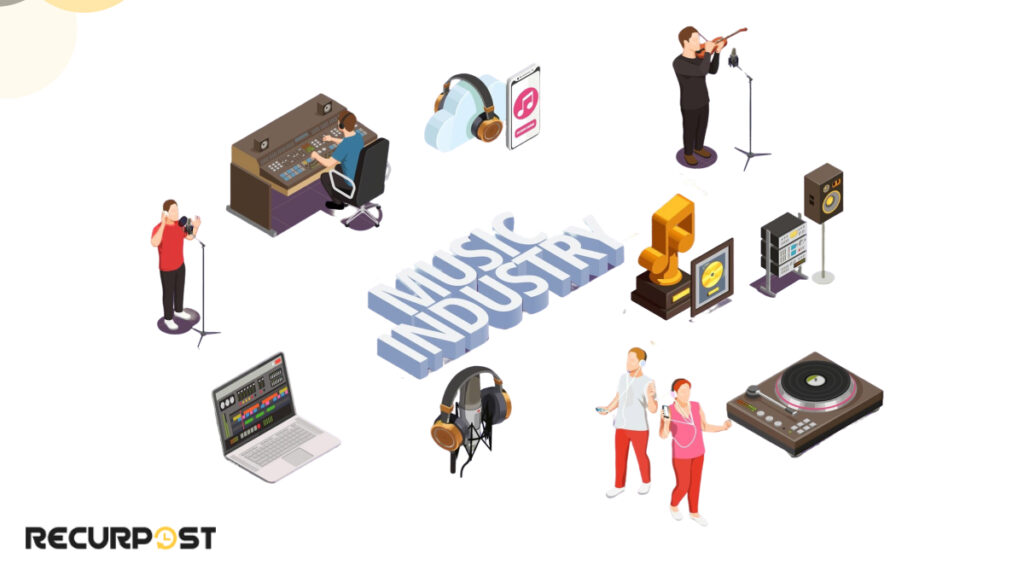
The global recorded music revenue has seen consistent growth, increasing for the 10th consecutive year in 2024 to US$29.6 billion, signaling a strong trend in digital engagement. As one of the industries that need social media marketing, the music industry thrives on visibility, hype, and direct fan connections—and social media platforms provide the perfect stage for all of these. Musicians, labels, and producers can leverage these platforms to showcase their talent, build fan bases, and drive career growth.
A focused social media strategy can help music businesses generate optimal attention and growth, whether it’s labels launching albums, producers sharing teasers of new beats, or announcing music festivals. The ability to engage directly with fans in real-time accelerates growth and enhances artist visibility.
Key benefits of social media marketing for music artists include:
- Boosting Visibility & Streaming Numbers: Social media platforms like TikTok and Instagram are perfect for short-form content, helping artists discover new music, repurpose old tracks, and drive engagement. These platforms help artists reach wide audiences and gain visibility that may otherwise take years to achieve.
- Fan Loyalty & Engagement: Creating direct connections with fans boosts loyalty and keeps audiences engaged. Platforms like YouTube and Spotify offer opportunities to create personalized journeys, allowing fans to discover new music and stay up-to-date with artists’ latest releases.
- Brand Building: Any social network is a great place for musicians to build a personal brand. Platforms like SoundCloud and Bandcamp allow musicians to showcase their art, connect with potential fans, and promote their music, offering a unique space to grow their presence in the industry.
- Teasers & Announcements: A well-planned social media strategy is essential for album releases, exclusive music teasers, and event promotions. Leveraging hype and exclusive content keeps fans excited and eager for new releases.
10. Photography
Ideal Platforms: Instagram, Pinterest, Facebook, Behance, 500px
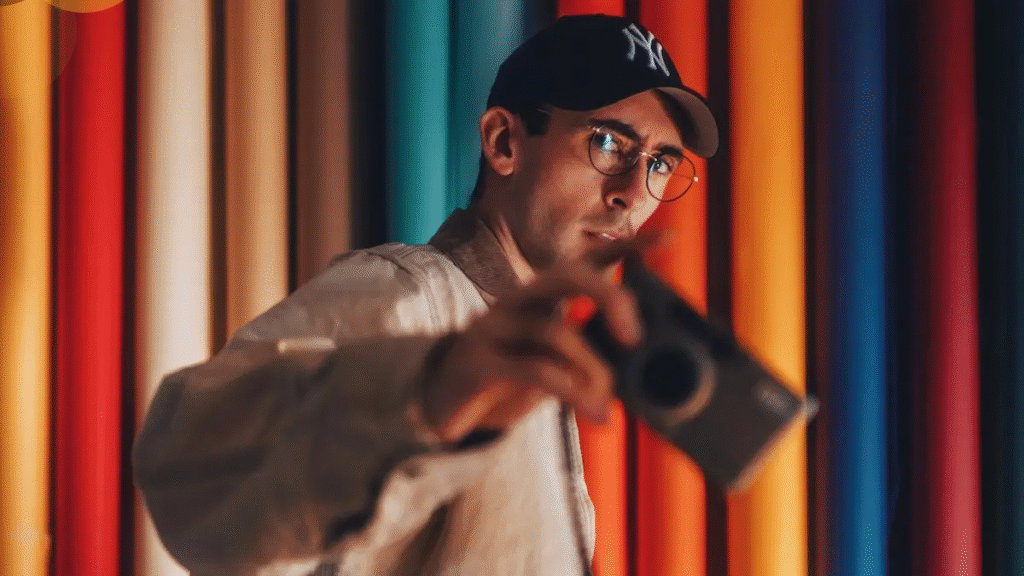
For photographers, social media serves as both a gallery and a powerful marketing tool. Social media marketing has become indispensable for photographers aiming to gain clients, showcase their signature styles, and build their recognition. As one of the industries that need social media marketing, photographers can leverage platforms like Instagram and Pinterest to reach a global audience and grow their professional presence.
A strategic social media strategy for photographers helps ensure optimal results when compelling visuals, storytelling, and behind-the-scenes (BTS) content are carefully planned and tailored to the target audience. These tactics create deeper connections with followers and potential clients, effectively promoting a photographer’s work.
Key strategies for photographers include:
- Instagram & Pinterest: These platforms are ideal for photographers to showcase their work visually. Instagram is known for its high engagement and visual-centric format, while Pinterest allows photographers to curate and share collections of their work, driving traffic and exposure.
- Behance & 500px: Platforms like Behance and 500px provide spaces where photographers can share their portfolios and connect with other professionals. These platforms are where social networks for photographers truly work, enabling them to display their best work and engage with like-minded individuals in the creative industry.
- Hashtags & Aesthetic Uniformity: To optimize social media profiles, photographers should incorporate targeted hashtags, maintain aesthetic uniformity, and write detailed captions that resonate with their audience. This approach helps drive engagement, improve visibility, and foster professional growth for aspiring photographers.
11. eCommerce
Ideal Platforms: Instagram, Facebook, TikTok, Pinterest, YouTube
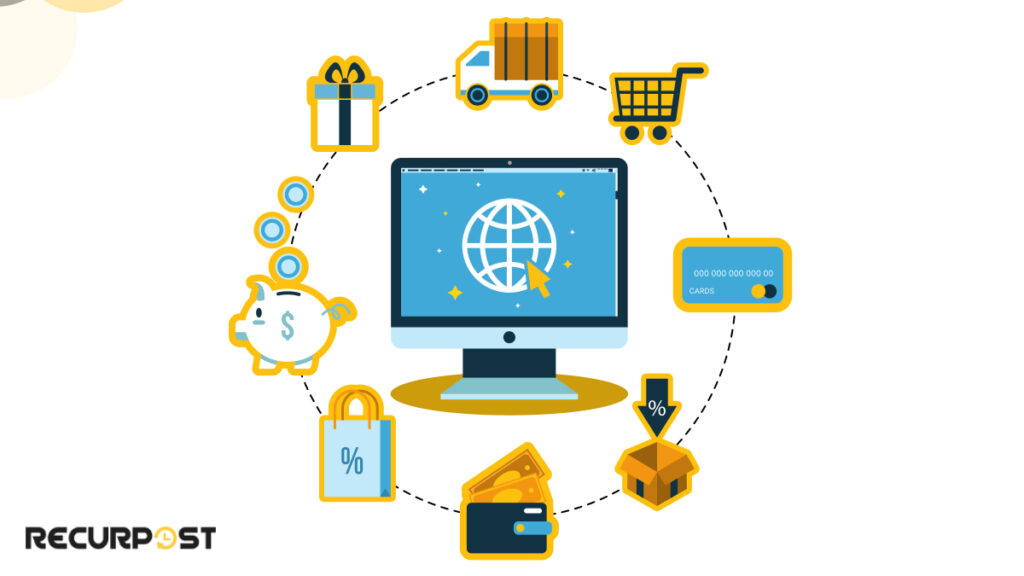
The eCommerce industry thrives on online visibility and engagement, and social media marketing plays a crucial role in driving traffic, boosting conversions, and building brand loyalty. As one of the industries that need social media marketing, eCommerce businesses must adopt innovative and dynamic strategies to remain competitive in a market projected to grow steadily through 2029, despite occasional ups and downs.
Social media eCommerce strategies like shoppable posts on Instagram and Facebook provide seamless purchasing experiences for users, helping businesses turn engagement into sales. TikTok is an ideal platform for creating viral product videos that capture attention, while Pinterest offers a visual discovery experience, making it the perfect platform to showcase products and guide customers through a smooth journey from interest to purchase.
Key strategies for eCommerce brands include:
- User-Generated Content & Influencer Partnerships: Brands can build trust and reach a wider audience by leveraging user-generated content (UGC) and influencer partnerships. These strategies help brands connect with consumers on a deeper level and amplify their message.
- Targeted Ads & Personalization: Integrating targeted ads and AI-powered chatbots helps businesses engage customers more effectively by providing personalized interactions and improving customer satisfaction. Personalization and data-driven content are key to enhancing the customer experience and ensuring repeat business.
- Consistent Branding & Product-Rich Content: One of the primary roles of social media marketing for eCommerce is optimizing the brand’s online presence. Maintaining consistent branding, providing direct purchase links, and sharing product-rich content are essential for driving sales and reinforcing brand recognition.
12. Sports
Ideal Platforms: Instagram, Twitter (X), YouTube, TikTok, Facebook

Social media in sports has completely transformed how fans connect with athletes, teams, and events. According to Deloitte’s 2024 Sports Industry Outlook, sports entities are actively leveraging fan data analytics to create personalized experiences and boost revenue. This new approach has reshaped engagement across the sports industry, making social media marketing an essential tool for teams and athletes alike. As one of the industries that need social media marketing, sports organizations are using digital platforms to expand their fanbase and enhance their brand presence.
Social media marketing for athletes can be a game-changer, helping them build a personal brand, secure sponsorships, and maintain strong relationships with followers. At the same time, sports teams and leagues utilize social media to sell tickets, promote merchandise, and foster fan communities.
Creative content ideas for sports marketing include:
- Match-Day Highlights & Athlete Takeovers: Share exciting match-day moments, or let athletes take over the team’s social accounts for more personal engagement with fans.
- Training Snippets & Live Q&As: Offer behind-the-scenes looks into training sessions and host live Q&A sessions with athletes or coaches.
- Fan Polls & Interactive Content: Engaging your audience through fan polls, challenges, or even trivia games boosts interaction and helps maintain fan excitement.
These types of content are effective in generating buzz and expanding reach across various platforms, ensuring the sport remains in the public eye and fostering deeper connections with fans.
13. Financial Services
Ideal Platforms: LinkedIn, Twitter (X), Facebook, YouTube, Instagram
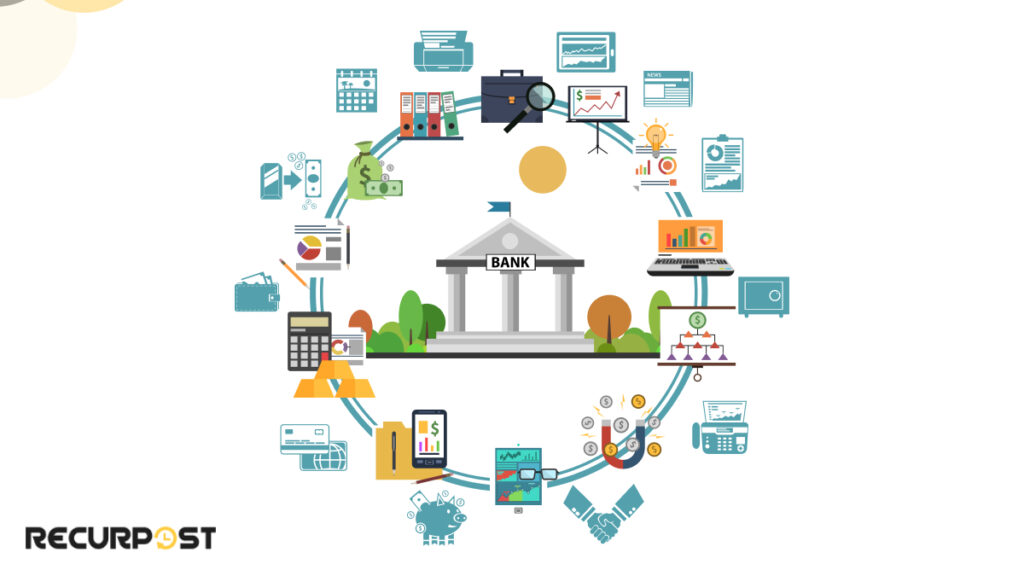
Social media for financial services has evolved from a compliance-heavy space into a powerful tool for building trust, providing education, and generating leads. Financial brands are increasingly turning to social media to simplify complex topics, build authority, and engage with their audiences in real time. As one of the industries that need social media marketing, the financial services industry is making great strides in using digital platforms to connect with clients and prospects. According to Forbes, while promoting financial services online is highly regulated, it can be incredibly rewarding when done correctly.
For an effective financial services social media strategy, businesses can post market insights, money management tips, regulatory updates, and client success stories to keep followers informed and engaged.
Key platforms and content strategies include:
- LinkedIn & Twitter/X: These platforms are ideal for showcasing thought leadership, building professional relationships, and sharing industry-specific updates. Financial professionals can use LinkedIn to engage with peers and prospects while demonstrating their expertise.
- Instagram & YouTube: Perfect for creating explainers and storytelling content, these visual platforms help financial services businesses break down complex concepts, making them more digestible for a wider audience.
Social media for financial professionals also plays a crucial role in establishing credibility, showcasing expertise, and building one-on-one relationships with clients, especially for advisors, planners, and consultants.
13 Real-life Businesses that Use Social Media Marketing
#1 Brookfield Asset Management
Brookfield Asset Management is a multinational Canadian corporation known for its expertise in real estate, renewable energy, and infrastructure. The company successfully educates its audience by sharing articles, visuals, and videos on platforms like LinkedIn, Twitter(X), and YouTube, showcasing its leadership and industry knowledge. By doing so, Brookfield strengthens its position as an authority in these sectors and connects with its global audience.
#2 Fenty Beauty
Fenty Beauty is a prime example of how to succeed in social media marketing within the beauty industry. Since its launch, Fenty Beauty has been praised for its inclusivity and diversity. The brand ensures that its audience feels represented by featuring models and influencers from diverse backgrounds. Active on Instagram, Twitter(X), and Facebook, Fenty Beauty frequently shows real people using its products, creating genuine connections and driving brand loyalty.
#3 IKEA
IKEA is a marketing giant known for its out-of-the-box ideas in both offline and digital marketing. The company uses YouTube, Facebook, Instagram, and Twitter(X) to maintain a cohesive online and offline presence. IKEA’s creative campaigns and strong social media presence have helped it stay at the forefront of the retail industry.
#4 Icehotel
The Icehotel in Sweden, the world’s first hotel built entirely from ice and snow, uses Instagram, Twitter(X), and YouTube to promote its unique services. Each winter, the hotel rebuilds itself with new room designs and exhibits such as an ice sculpture museum and ice bar. Social media allows Icehotel to showcase its stunning offerings, attracting global attention to its exclusive and one-of-a-kind experience.
#5 Curry Corner
Curry Corner, an Indian eatery and bar in Minneapolis, has seen remarkable success using social media. By sharing interaction videos with prospective guests, often going viral on Instagram, the restaurant has effectively boosted its visibility and business. This is an excellent example of social media marketing for small businesses, proving that even limited resources can lead to a significant impact.
#6 WHO
The World Health Organization (WHO) uses YouTube, Twitter(X), Instagram, and Facebook to reach a global audience with essential health information. With its omnichannel presence, WHO engages with various generations, providing real-time updates on health crises and policy initiatives. WHO’s social media marketing strategies are a role model for the healthcare industry, demonstrating how digital platforms can drive awareness and action.
#7 Marvel Studios
Marvel Studios is a standout example in the entertainment industry for its social media marketing. The company uses Instagram, Twitter(X), Facebook, YouTube, and TikTok to generate excitement for its films. By planning BTS (behind-the-scenes) content, trailers, live sessions, influencer partnerships, and sponsored content, Marvel Studios creates a highly engaged community of fans, driving both online and offline engagement.
#8 UNICEF
UNICEF excels in social media marketing for NGOs, constantly sharing its ongoing campaigns on Instagram, Facebook, Twitter (X), and YouTube. Through compelling content and powerful storytelling, UNICEF effectively spreads awareness and mobilizes resources for its cause, showcasing the power of social media to drive social change and create global impact.
#9 Coachella
Coachella leverages viral content, live updates, and fan engagement across platforms like Instagram, TikTok, YouTube, Facebook, and Twitter (X). By engaging with fans in real time and sharing exclusive content, Coachella generates buzz long before the festival even begins. Their social media marketing strategy helps them stay top of mind and continuously build excitement year after year.
#10 Brandon Woelfel
Brandon Woelfel, a renowned portrait photographer, uses Instagram and YouTube to showcase his signature dreamy edits and creative photo shoots. By sharing his process and behind-the-scenes content, Brandon creates a personal brand that resonates with his audience. His social media marketing helps him build credibility and connect with potential clients.
#11 Glossier
Glossier, a digital-first brand, excels in using Instagram and TikTok to share user-generated content (UGC), product tips, and brand stories. This approach not only strengthens customer loyalty but also drives online sales, turning followers into dedicated customers and brand advocates.
#12 FC Barcelona
FC Barcelona is one of the most-followed sports organizations globally. By sharing behind-the-scenes content, match recaps, and fan-driven campaigns on Instagram, TikTok, and YouTube, the club engages its fans and strengthens its global brand. Through interactive content and regular updates, FC Barcelona has built a loyal and passionate following, leveraging social media to create an intimate connection with fans.
#13 Morgan Stanley
Morgan Stanley uses LinkedIn and Twitter/X to position itself as a trusted voice in the global financial industry. Through investment trend updates, educational videos, and expert commentary, Morgan Stanley provides valuable insights to its audience, building authority and trust through strategic social media content.
How To Implement Social Media Strategy in Any Industry?
Companies across various industries use social media marketing through straightforward, strategic approaches. Below, we’ve outlined a step-by-step guide to help you develop an industry-specific social media strategy for your business. Whether you’re just starting a career in social media marketing or looking to optimize your current approach, these steps will ensure you have a clear and effective workflow.
Step 1: Set a Clear Goal
The first step in any social media marketing strategy, especially for small businesses, is to define the main goals of your efforts.
Step 2: Filter Target Audience
Conducting thorough research on your target audience is crucial. Understand the demographics (age, location, income, etc.) and psychographics (values, interests, and behavior) of your audience. This information will help you develop a comprehensive marketing plan and a targeted social media strategy that speaks directly to your ideal customer.
Step 3: Identify Lucrative Platforms
Identifying the right platforms is key. Choose platforms that best align with your industry and audience preferences. For example, Instagram and TikTok might be ideal for visual-driven industries like fashion and beauty, while LinkedIn is more suited for B2B services or professional services.
Step 4: Strategic Content Creation
Create creative, relevant, and diversified social media post ideas that align with your brand and resonate with your target audience. A good mix of visual content, videos, infographics, and customer testimonials can help differentiate your business in a competitive market.
Step 5: Survey & Modify
Social media marketing is an ongoing process. Use analytics tools to measure the effectiveness of your posts and strategies. Keep an eye on metrics like engagement rates, conversion rates, and audience growth. Based on this data, modify and adjust your strategies to improve performance and adapt to new trends.
Use RecurPost for Social Media Marketing for Different Industries
RecurPost, our powerful Social Media Management Tool, is designed to handle complex social media posting with automation and helps you manage cross-platform activities seamlessly from one centralized platform. It enables businesses to efficiently control and engage multiple social media accounts, ensuring consistent and effective interactions with their audience.
Key features:
- Support for All Major Social Networks
- Centralized Control
- Multiple Workspace Management
- RSS Feeds
- White Label Reporting
- AI Support
- Recurring Libraries for Evergreen Content
To Sum Up
Industries that need social media marketing require specific 2025 social media marketing approaches tailored to their unique characteristics, audiences, and market dynamics. Social media enhances customer engagement and service as brands adapt strategies to meet the evolving expectations of digital-age consumers. Industry-specific social media posts help connect businesses with individuals, build trust, and foster long-term relationships, while insights from measurement tools drive continuous improvement.
Frequently Asked Questions
1) Which industries are the most appropriate for social media marketing?
Travel, health & wellness, fashion, beauty, education, recruitment, real estate, and entertainment are some of the prime industries that need social media marketing and are taking full advantage of digital platforms to engage with their audiences.
2) How does social media marketing impact an industry?
Targeted social media marketing platforms influence customer relationships, business turnover, and overall business performance by improving brand visibility, increasing customer engagement, and driving conversions.
3) Which industry benefits the most from social media marketing services?
The entertainment industry benefits the most from social media marketing services, as it thrives on constant engagement, fan interaction, and the ability to create viral moments that drive visibility and revenue.
4) How can real estate professionals use social media effectively?
The real estate industry frequently uses Facebook and Instagram to advertise properties, engage in direct interactions with prospective buyers, and foster customer relationships through valuable content and community building.
5) Why is audience understanding important in social media marketing?
Understanding the target audience, including their preferences and requirements, is essential for designing compelling, relevant campaigns that resonate with potential customers and drive business growth.

Ruchi Dhimar is a skilled content writer with 4 years of experience. She is passionate about crafting compelling narratives, specializing in writing content for different industries.
